![]() November - December 2002
November - December 2002
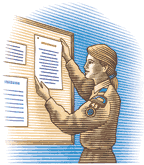
|
Edited by Scott Daniels |
Enter the Boys' Life reading contest
Young readers have two months left to enter the 2002 Boys' Life "Say Yes to Reading!" contest. Entrants write a one-page report on "The Best Book I Read This Year." Books can be fiction or nonfiction. Enter reports in one of three age categories: 8 years old and younger; 9 and 10 years old; 11 years and older.

The contest is open to all Boys' Life readers. All entrants receive a free Pedro patch—but only if they include a letter-size, stamped (37 cents), self-addressed envelope with their report. (Include name, address, age, and school grade with each book report.)
The top three winners from each age group will also get a Leatherman multi-tool (or any two books they want), copies of Codemaster books 1 and 2, the limited edition Codemaster pin-and-patch set, and their names announced in Boys' Life.
Send all reports and stamped return envelopes for the free patch to Boys' Life Reading Contest, S306, P.O. Box 152079, Irving, TX 75015-2079. Entries must be postmarked no later than Dec. 31, 2002.
Local and national tour permits add Youth Protection requirements
Effective January 2003, both the Local Tour Permit Application (BSA No. 34426B) and the National Tour Permit Application (No. 4419B) will require that at least one adult present during the event or activity must have completed BSA Youth Protection Training.
National tour permits are required for Scout tours or trips of 500 miles or more (one way). And when such trips involve a nationally sponsored event or activity, all registered adults must have completed BSA Youth Protection Training. (An online version of the required training for leaders is scheduled to be available by January.)
Council guidelines determine when a local tour permit is required. While most short, in-town den trips of a few hours do not require a permit, it is recommended that dens obtain permission slips from parents.
Completing a tour permit application reinforces leader requirements for transportation, aquatics, climbing, and Youth Protection.
Get the latest version of tour permit applications at council service centers or from the BSA Web site at www.scouting.org/pubs/gss/gssax.html.
European camps seek BSA Scouters
The European Camp Staff Program offers BSA Scouters an opportunity to work as a volunteer staff member at a European Scout camp. Applicants must be registered BSA members, between 18 and 30 years of age, and able to commit to a minimum of six weeks.
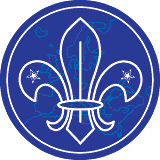
Although participants pay their own travel to and from their assigned Scout center, the European Scout Region will refund up to 50 percent of an individual's travel costs. Also, the Order of the Arrow offers a limited number of scholarships to Arrowmen ages 18 through 20.
Deadline for applying is May 15, 2003. Information booklets and applications (which require local Scout council approval) are available from the BSA International Division, 1325 W. Walnut Hill Ln., P.O. Box 152079, Irving, TX 75015-2079.
Fly-Fishing is newest merit badge
The sport of fly-fishing and the related art of fly-tying are the subjects of Boy Scouting's newest merit badge.
The merit badge pamphlet Fly-Fishing (BSA No. 33283) was released in June. Requirements cover equipment, safety, legal restrictions, fishing skills, live bait, fly-tying techniques, and the importance of Leave No Trace principles. Scouts must also use fly-fishing techniques to "catch two different kinds of fish and identify them. Release at least one of them unharmed. Clean and cook another fish."
Fly-fishing brings the number of merit badges available to Boy Scouts to 119. Among these, the pamphlets for Fishing (No. 33231A) and Sports (No. 35007) also include possible fly-fishing activities.
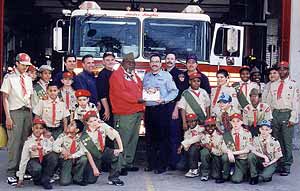 SCOUTS HONOR NYC HEROES In March, Scouts from the Greater New York Councils visited city fire stations, police precincts, emergency service units, and EMS garages to present special BSA certificates saluting the bravery of men and women in rescue efforts following the attacks of Sept. 11, 2001. Above, Scoutmaster Harvey Johnson and Scouts from Staten Island's Troop 180 deliver a certificate of appreciation to a Staten Island fire station. |
Eagle Scout receives honor for community service project
At a June ceremony in Washington, D.C., Joseph DiRenzo IV, an Eagle Scout in Troop 16, Suffolk, Va., was one of 57 local "unsung heroes" from across the nation honored with a Jefferson Award for outstanding community and public service.
 U.S. Senator John McCain congratulates Joseph for his award-winning project. |
Since 1972, the awards have been presented by the American Institute for Public Service, an organization founded for that purpose by Sam Beard, a longtime advisor to several presidents, and by the late Jacqueline Kennedy Onassis and the U.S. senator Robert Taft Jr.
From more than 12,500 nominees nationwide, local media sponsors each choose five to six winners. A national panel then selects one individual from each sponsor area to be honored in a ceremony in the nation's capital.
The youngest of the 57 regional honorees in 2002, Joseph was cited for an Eagle Scout project that provided educational supplies for the St. Fortunatus House orphanage in Haiti. The project has since expanded to include other needed items, such as clothing, shoes, and recreational equipment, and he writes regularly to the orphanage to determine their needs.
See www.aips.org for more information on the Jefferson Award and the location of participating local media sponsors. Joseph maintains a Web site, www.members.tripod.com/joeydirenzoiv/default.html, with details about his project.
Council high adventure bases listed on BSA Web site
Scout troops, Venturing crews, and other groups can now find information about 60 or more council-operated high adventure programs on the BSA Web site, www.scouting.org/boyscouts/directory.
Council programs that involve trekking for at least five nights and six days are listed, along with a few specialty programs of shorter duration. All programs are pinpointed on a map of the United States and each listing includes a brief description, length, cost, directions to the base, and how to obtain more information.
Programs include canoeing, backpacking, caving, horse and llama treks, sailing, whitewater, mountain biking, and peak climbing.
A similar list is included in the BSA manual Passport to High Adventure (BSA No. 4310). However, the Web site list will allow for a more timely updating of information and the addition of new programs.
Scouts help preserve memories of U.S. war veterans
Boy Scouts in New Jersey are working to ensure that the records and memories of those who fought for their country in World War II and other conflicts are preserved for posterity.
At the request of American Legion officials, Troop 25 of Riverside, N.J., has tracked down the graves of scores of "lost" veterans in its area.
Troop 25 has spent nearly three years in an ongoing effort to locate the burial sites of all veterans in three local cemeteries and produce a comprehensive catalog containing their names, locations, and other information.
"So far, we've found information on 466 veterans—from the Civil War through the conflict in Grenada," says assistant Scoutmaster Steve Miller Sr. "Before we started, the Legion had records on only 349 veterans buried in the area."
Miller's son, Steve Jr., made the search his Eagle Scout project, and other members of the troop joined in the campaign. The Scouts created maps to help pinpoint the veterans' gravesites and developed a database of all available personal information on deceased veterans.
Finally, they compiled and produced a 34-page booklet containing the information they had uncovered. The booklet was distributed free to Riverside residents on Memorial Day as part of the community observance of the holiday.
"Our Scouts devoted hundreds of man-hours to this project, and the outcome far exceeded the Legion's expectations," said Miller Sr. "A lot of that time was spent trudging through cemeteries and examining every old gravestone. In the process, we located the graves of many heroes, including one Civil War Medal of Honor winner that everyone had simply lost track of."
The troop plans to reproduce the booklet for distribution again on each succeeding Memorial Day, he said. This year's updated version will include a "living remembrance" section for surviving veterans and their families.
Scouts rescue a historic trail
For the second time, Scouts and Scouters from Michigan's Lake Huron Area Council have rebuilt a historic migratory Indian trail.
Both projects, some 40 years apart, were led by Joe Bevirt, now 70. The first, in the 1960's, came after Bevirt read in a book how Indians had used the 210-mile Midland-to-Mackinac Trail to bring copper from Michigan's Upper Peninsula to trade for other goods.
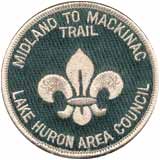
An Explorer post leader at the time, Bevirt enlisted hundreds of Scouts in the effort to reestablish a "game-trail-like footpath." To assist hikers, they marked the route, which took 11 days to hike, with 2-by-6-inch blue vertical blazes on trees and posted signs.
However, over decades the trail deteriorated into numerous unconnected segments. "Portions started disappearing through clear-cutting by logging companies, habitat feeding, and the thin soil being turned into sandpiles by motorcycles," Bevirt recalled.
In the mid-90's, Michigan's Department of Natural Resources asked Bevirt, by then retired from his job as a county economic developer, to rebuild the path. The agency, which 40 years earlier had expressed doubts that volunteers could complete the job, offered assurances that this time the trail would be protected from loggers and others who would destroy its footpath. Michigan's governor, John Engler, also pledged support for the project.
Over four months, Joe and his wife, Willi, assisted by Scouter Don White, located and rough-marked the entire 210-mile trail.
The following year (1999) hundreds of Lake Huron Area Council Scouts and Scouters joined the project. They cleared brush and fallen trees, painted or repainted thousands of blue markers on trees, and posted durable trail signs on eight-foot cedar posts. They also built bridges, some up to 45 feet long, often lugging materials to remote locations on their shoulders or in backpacks.
Funding came entirely from private donations and was sufficient to produce a colorful map of the trail, noting access points, camping areas, and locations of well water. Forty troops from the Lake Huron Area Council have each pledged to maintain a four- to six-mile segment.
In May 2001, more than 230 people gathered at the south trailhead to dedicate and celebrate the reopening of the trail. A dozen Native Americans performed ritual dances. They also scattered ground tobacco leaves, as is their tradition, to ensure that, this time, the trail would be "cared for and respected."
(Editor's note: Joe Bevirt has been a Lake Huron Area Council Executive Board member since 1962. Willi Bevirt is on the council's advisory board.)
A Good Turn RememberedBy Sig Kagawa, board member, Aloha Council, Honolulu, HawaiiThe impact of an act of kindness can extend far beyond the moment it occurs, touching countless additional lives along the way... 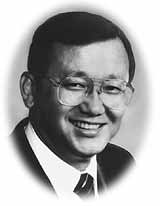
(Editor's note: The following was condensed from an account written in 2000 for inclusion in a time capsule in the Aloha Council's new service center in Honolulu, Hawaii. The author describes an incident that occurred in 1944, after his family was released from a Japanese-American internment camp in Arkansas and sent to live in Des Moines, Iowa, far from their home in Hawaii.) ...My father was put to work [in Des Moines] for the War Relocation Authority, a government agency responsible for arranging and coordinating the relocation of Japanese-Americans being released from the concentration camps. ...I went to a school located about a mile from where we lived, and I walked both ways each day. The United States was still at war with Japan, and anti-Japanese propaganda had inflamed hateful passions against all Japanese, even loyal American citizens of Japanese ancestry. So it was not uncommon for gangs of boys to confront me on my walk, scream nasty epithets, throw rocks, kick me, and spit at me. It was the most difficult time of my life. Then one day, a group of young boys came to me and said they were going to escort me to and from school to protect me, which they did for many weeks until the harassment ended. My protectors were Boy Scouts from a troop at nearby Hanawalt School; they had learned of my plight and decided to protect me as their daily Good Turn. You cannot imagine how liberating it was to have that daily dread removed from my life. I appreciated it so much that I said that someday I would find a way to express my appreciation by doing whatever I could to help the Boy Scouts. After college, I returned home to Hawaii and offered to become a volunteer for the Aloha Council. I have been a volunteer ever since. Throughout my service with the Boy Scouts, I have met many good people who give of themselves for the betterment of our young people and who, at the same time, reap wonderful personal rewards for themselves. They are much like those boys in Iowa who helped me in my most difficult times. Many years from now, when this time capsule is opened, I hope the people who read this, and our country itself, will have long transcended the passions and prejudices that resulted in the kinds of events I have described. Whether or not we get there, I am sure that the people involved in Scouting will be as good as those I have met and worked with, and as good as those Iowa Boy Scouts of so many years ago. |
Program Resources by the Day, Week and Month
NOV. 13 Kindness is contagious.Help spread compassion on World Kindness Day, an international celebration sponsored by the Random Acts of Kindness Foundation. For project ideas for kids of all ages, see www.actsofkindness.org or call (800) 660-2811.
NOV. 15 Clean up your act.Some 46 states and two territories annually participate in America Recycles Day by promoting recycling and recycled products. For information on organizing a recycling event in your community, see www.americarecyclesday.org or call (202) 347-0450, ext. 25.
NOV.-DEC. Play board games with family and friends.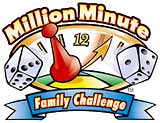
The second annual Million Minute Family Challenge, sponsored by Patch Products, Inc., encourages interaction and communication among family and friends through playing board games. Register minutes spent playing board games through December at www.millionminute.com, where you'll also find games, ideas on participation, and information on the history of games and the benefits of family time. —Melanie Radzicki McManus |
Philmont Training Center Offers Learning Opportunities For Summer and Fall 2003The Philmont Training Center (PTC), the BSA national facility at Philmont Scout Ranch near Cimarron, N.M., offers weeklong training conferences from June through September for council, district, and unit volunteers, professional Scouters, and junior leaders. Also available are age-specific activities for family members, including (except during weeks 1 and 12) a Mountain Trek Hiking program for youth 14 to 20 years old. Philmont is located in the foothills of the Sangre de Cristo Mountains of northeastern New Mexico. The area is rich in history and natural beauty, and the conference schedule allows time for family activities, day hiking, and recreation. Families arrive on Sunday and depart the following Saturday. Meals are served in dining halls; housing is in large, two-person wall tents on platforms, located near showers and restrooms, medical facilities, and recreation areas. Conferences feature the latest tools, audiovisuals, and techniques, and are led by a faculty of experienced Scouters. Fees include meals, lodging, and conference and family program materials: conference participants, $320; spouses and children over 20, $235; children ages 6 to 20, $190; ages 3 to 5, $125; 2 and under, $40; Mountain Trek, $245; and National Junior Leader Instructor Camp (NJLIC), $245. Participants must have local council approval; some conferences require strong Boy Scout camping skills and/or top physical conditioning. Contact your local Scout council service center or the Philmont Training Center, Cimarron, NM 87714, phone (505) 376-2281, fax (505) 376-2629, e-mail trainingcenter@philmontscoutranch.org. More information is also available at www.scouting.org/philmont.
PTC Summer / Fall Schedule for 2003
June 1-7: Boy Scouting/Scoutreach.
June 8-14: Venturing.
June 15-21: Council and District Operations/Finance.
June 22-28: Cub Scouting.
June 28-July 4: Mormon Relationships Week.
July 6-12: Religious Relationships/Boy Scouting.
July 13-19: Council and District Operations/Professional Development.
July 20-26: Cub Scouting.
July 27-Aug. 2: Council and District Operations/Professional Development.
Aug. 3-9: Finance Support/Boy Scouting.
Aug. 10-16: Boy Scouting.
Sept. 14-20: Boy Scout Fall Conference Week. *Requires signed Philmont physical |
November-December 2002 Table of Contents
Copyright © 2002 by the Boy Scouts of America. All rights thereunder reserved; anything appearing in Scouting magazine or on its Web site may not be reprinted either wholly or in part without written permission. Because of freedom given authors, opinions may not reflect official concurrence.
| The Boy Scouts of America | http://www.scouting.org |